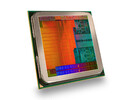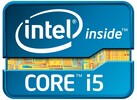AMD A10-7400P vs Intel Core i5-2410M vs Intel Core i5-2537M
AMD A10-7400P
► remove from comparison
Der AMD A10-7400P ist ein mobiler Quad-Core-Prozessor der Mittelklasse, der auf der Kaveri-Architektur basiert und im Juni 2014 vorgestellt wurde. Zusätzlich zu den zwei CPU-Modulen (4 Integer-Kerne) integriert der Chip auch eine Radeon-R6-Grafikeinheit mit 384 GCN-Shadern sowie einen Dual-Channel DDR3-1866 Speichercontroller. Die Taktraten liegen bei 2,5 bis 3,4 GHz für den Prozessor und 654 MHz für die GPU.
Architektur
Kaveri tritt die Nachfolge der 2013 vorgestellten Richland-Architektur (z.B. A10-5750M) an. Die überarbeiteten CPU-Kerne, Codename Steamroller, repräsentieren die dritte Ausbaustufe des Bulldozer-Designs. AMD hat unter anderem die Decoder modifiziert (nunmehr jeweils einer pro Integer-Kern), die Sprungvorhersage optimiert und den L1-I-Cache von 64 auf 96 KB pro Modul vergrößert, wodurch die Pro-MHz-Leistung leicht verbessert werden konnte. Alle Details zur Kaveri-Architektur haben wir in einem Spezialartikel zusammengestellt:
Analyse der AMD Kaveri Notebook-Plattform
Performance
Entsprechend der angegebenen Taktrate sowie der gesteigerten Pro-MHz-Leistung sollte der A10-7400P eine CPU-Performance auf dem Niveau des Sandy-Bridge-basierten Intel Core i3-2330M oder i3-2350M bieten. Damit besitzt der Prozessor nicht nur für alle alltäglichen Programme, sondern auch für anspruchsvollere Software und leichtes Multitasking ausreichende Reserven.
Grafikeinheit
Die Radeon R6 (Kaveri) Grafikeinheit des A10-7400P verfügt über 384 Shadereinheiten, die mit bis zu 654 MHz takten. Da die GPU auf AMDs GCN-1.1-Architektur basiert, werden sowohl DirectX 11.2 "Tier 2" als auch die Mantle-API unterstützt. Per OpenCL können verschiedene Anwendungen, beispielsweise Adobe Photoshop, zusätzlich beschleunigt werden.
In puncto 3D-Performance profitiert die GPU nicht nur von ihrer hohen Rechenleistung, sondern auch der Speicherunterstützung bis DDR3-1866. Im Mittel sollte die Performance nur knapp unter einer dedizierten GeForce GT 730M liegen. Viele aktuelle Spiele können in niedrigen, teils auch mittleren Einstellungen und WXGA-Auflösung flüssig dargestellt werden.
Leistungsaufnahme
Die Leistungsaufnahme der gesamten APU liegt bei 35 Watt, was vergleichbar mit gängigen Mittelklassemodellen der Konkurrenz ist. Damit ist der Chip, der in einem 28 nm SHP-Prozess von Globalfoundries gefertigt wird, am besten für Notebooks ab etwa 14 Zoll geeignet.
Intel Core i5-2410M
► remove from comparison
The Intel Core i5-2410M is a fast dual core processor at the time of introduction in Q1 2011. It is based on the Sandy Bridge architecture and offers Hyperthreading to handle 4 threads at once (for a better usage of the pipeline). Compared to the faster Core i7, the i5 offers a smaller last level cache of 3MB. The base clock speed is 2.3 GHz but due to Turbo Boost it can reach 2.6 GHz (2 cores active) and 2.9 GHz (1 core active). Compared to the 2510M, the 2410M does not support AES, VT-d, and Trusted Execution functions.
Sandy Bridge is the evolutionary successor of the Arrandale architecture. The most noteable improvements is the improved Turbo 2.0 and the integration of the graphics card into the 32nm CPU core.
The i5-2410M offers an integrated graphics card (Intel HD Graphics 3000) which is clearly faster then the older Intel HD Graphics in the Arrandale CPUs. As the new GPU is included in the CPU, it is also manufactured in 32nm and shares the fast level 3 cache with the CPU cores (using a new ring bus). In the 2410M it is clocked from 650-1200MHz (with Turbo Boost). The faster Sandy Bridge CPUs are clocked up to 1300 MHz (like the i5-2520M).
Furthermore, an improved dual-channel DDR3 memory controller is included on the CPU die that is used by the CPU and GPU part.
Due to the improved architecture and the new Turbo Boost 2.0, the average performance of the Core i5-2410M is higher than a similar clocked Arrandale Core i5. In our benchmarks, the 2410M was able to beat the fast Intel Core i5-560M with 2.7-3.2GHz and is therefore suited for even demanding tasks.
The 35W TDP rating includes the integrated GPU and memory controller.
Intel Core i5-2537M
► remove from comparison
Der Intel Core i5-2537M ist ein stromsparender ULV (Ultra Low Voltage) Prozessor für Subnotebooks. Mit 1.4 GHz Basistaktfrequenz ist er relativ gering getaktet, jedoch kann er dank Turbo Boost bis zu 2.3 GHz hochtakten (2 Ghz bei Belastung beider Kerne). Durch die Unterstützung von Hyperthreading können 4 Threads gleichzeitig bearbeitet werden.
Sandy Bridge ist eine Weiterentwicklung der Arrandale Architektur. Neben Optimierungen sind besonders die neuen 256 Bit AVX Instruktionen im CPU Teil und der verbesserte Turbo 2.0 erwähnenswert. Weiters sind nun ebenfalls AES Funktionen und ein verbesserter Dual Channel DDR3 Speicherkontroller für max. 8 GB DDR3-1333MHz direkt im Prozessor integriert.
Die intergrierte DirectX 10 fähige Intel HD Graphics 3000 Grafikkarte ist direkt in der CPU untergebracht und teilt sich mit dieser den Level 3 / Last Level Cache. Dadurch sinkt zwar die Prozessorleistung etwas bei aktivierter Grafik, die Grafikleistung ist jedoch deutlich besser als bei der alten Intel HD Graphics in ULV Notebooks. Vergleichen mit den stärkeren 35 Watt Doppelkernprozessoren ist die Grafikleistung jedoch aufgrund der geringeren Taktfrequenz deutlich schlechter (350 versus 650 MHz Basistakt, 900 versus 1100-1300 MHz Turbo Boost).
Die Performance liegt dank der verbesserten Architektur und des überarbeiteten Turbo Boost etwas oberhalb einer ähnlich getakteten Arrandale CPU. Dadurch sollte die Leistung auf dem Niveau des Core i7-680UM liegen und damit in der Nähe des Core i3-330M (falls der Turbo Boost dank ausreichend Kühlung gut funktioniert).
Die Sandy Bridge Doppelkernprozessoren beinhalten im angegebenen TDP von 17 Watt auch die Grafikkarte und den Speicherkontroller. Durch den Turbo Boost 2.0 wird der TDP jedoch unter Last eher ausgenutzt. Mit 17W TDP eignet sich der Prozessor auch für kleine und leichte Notebooks.
| Model | AMD A10-7400P | Intel Core i5-2410M | Intel Core i5-2537M | ||||||||||||||||||||||||||||||||||||||||||||||||||||||||||||||||||||||||||||||||||||||||||||||||||||||||||||||||||||||||
| Codename | Kaveri | Sandy Bridge | Sandy Bridge | ||||||||||||||||||||||||||||||||||||||||||||||||||||||||||||||||||||||||||||||||||||||||||||||||||||||||||||||||||||||||
| Series | AMD Kaveri | Intel Core i5 | Intel Core i5 | ||||||||||||||||||||||||||||||||||||||||||||||||||||||||||||||||||||||||||||||||||||||||||||||||||||||||||||||||||||||||
| Serie: Core i5 Sandy Bridge |
|
|
| ||||||||||||||||||||||||||||||||||||||||||||||||||||||||||||||||||||||||||||||||||||||||||||||||||||||||||||||||||||||||
| Clock | 2500 - 3400 MHz | 2300 - 2900 MHz | 1400 - 2300 MHz | ||||||||||||||||||||||||||||||||||||||||||||||||||||||||||||||||||||||||||||||||||||||||||||||||||||||||||||||||||||||||
| L2 Cache | 4 MB | 512 KB | 512 KB | ||||||||||||||||||||||||||||||||||||||||||||||||||||||||||||||||||||||||||||||||||||||||||||||||||||||||||||||||||||||||
| Cores / Threads | 4 / 4 | 2 / 4 | 2 / 4 | ||||||||||||||||||||||||||||||||||||||||||||||||||||||||||||||||||||||||||||||||||||||||||||||||||||||||||||||||||||||||
| TDP | 35 Watt | 35 Watt | 17 Watt | ||||||||||||||||||||||||||||||||||||||||||||||||||||||||||||||||||||||||||||||||||||||||||||||||||||||||||||||||||||||||
| Transistors | 2410 Million | 624 Million | 624 Million | ||||||||||||||||||||||||||||||||||||||||||||||||||||||||||||||||||||||||||||||||||||||||||||||||||||||||||||||||||||||||
| Technology | 28 nm | 32 nm | 32 nm | ||||||||||||||||||||||||||||||||||||||||||||||||||||||||||||||||||||||||||||||||||||||||||||||||||||||||||||||||||||||||
| Die Size | 245 mm2 | 149 mm2 | 149 mm2 | ||||||||||||||||||||||||||||||||||||||||||||||||||||||||||||||||||||||||||||||||||||||||||||||||||||||||||||||||||||||||
| max. Temp. | 102 °C | 100 °C | 100 °C | ||||||||||||||||||||||||||||||||||||||||||||||||||||||||||||||||||||||||||||||||||||||||||||||||||||||||||||||||||||||||
| Socket | BGA (FP3) | rPGA988B / BGA1023 | BGA1023 | ||||||||||||||||||||||||||||||||||||||||||||||||||||||||||||||||||||||||||||||||||||||||||||||||||||||||||||||||||||||||
| Features | SSE (1, 2, 3, 3S, 4.1, 4.2, 4A), x86-64, AES, AVX, FMA, DDR3-1866 Controller | HD Graphics 3000 (650-1200MHz), DDR3-1066/1333 Memory Controller (max 16GB), HyperThreading, AVX, Quick Sync, Virtualization | HD Graphics 3000 (350-900MHz), DDR3-1066/1333 Memory Controller (max 8GB), HyperThreading, AVX, Quick Sync, Virtualization | ||||||||||||||||||||||||||||||||||||||||||||||||||||||||||||||||||||||||||||||||||||||||||||||||||||||||||||||||||||||||
| iGPU | AMD Radeon R6 (Kaveri) (576 - 654 MHz) | Intel HD Graphics 3000 (650 - 1200 MHz) | Intel HD Graphics 3000 (350 - 900 MHz) | ||||||||||||||||||||||||||||||||||||||||||||||||||||||||||||||||||||||||||||||||||||||||||||||||||||||||||||||||||||||||
| Architecture | x86 | x86 | x86 | ||||||||||||||||||||||||||||||||||||||||||||||||||||||||||||||||||||||||||||||||||||||||||||||||||||||||||||||||||||||||
| Announced | |||||||||||||||||||||||||||||||||||||||||||||||||||||||||||||||||||||||||||||||||||||||||||||||||||||||||||||||||||||||||||
| Manufacturer | www.amd.com | ark.intel.com | ark.intel.com | ||||||||||||||||||||||||||||||||||||||||||||||||||||||||||||||||||||||||||||||||||||||||||||||||||||||||||||||||||||||||
| L1 Cache | 128 KB | 128 KB | |||||||||||||||||||||||||||||||||||||||||||||||||||||||||||||||||||||||||||||||||||||||||||||||||||||||||||||||||||||||||
| L3 Cache | 3 MB | 3 MB | |||||||||||||||||||||||||||||||||||||||||||||||||||||||||||||||||||||||||||||||||||||||||||||||||||||||||||||||||||||||||
| $250 U.S. |
Benchmarks
Average Benchmarks Intel Core i5-2410M → 0% n=0
Average Benchmarks Intel Core i5-2537M → 0% n=0
* Smaller numbers mean a higher performance
1 This benchmark is not used for the average calculation











